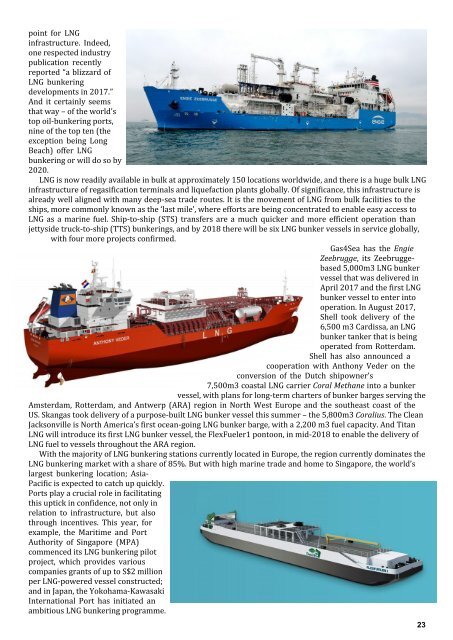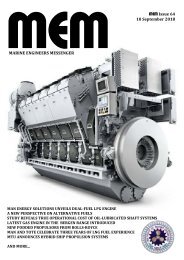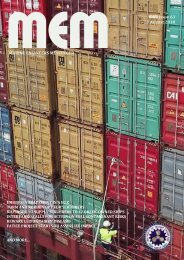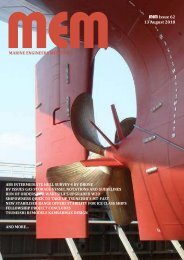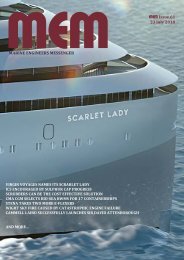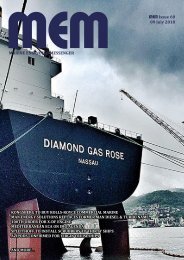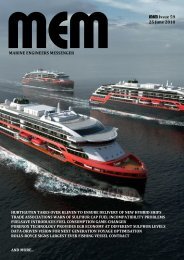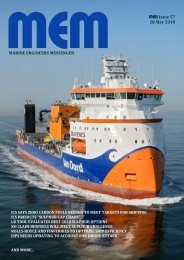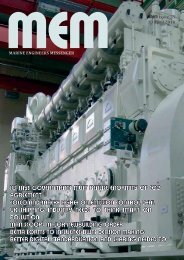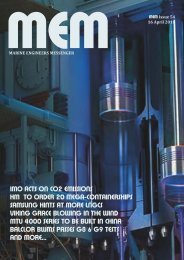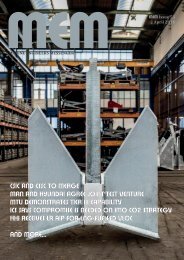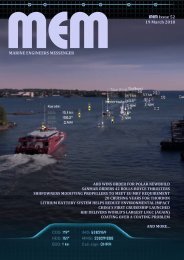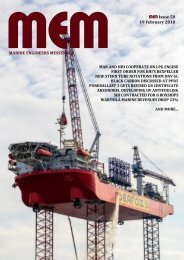MEM47
Marine Engineers Messenger, Volume 3, Issue 47
Marine Engineers Messenger, Volume 3, Issue 47
You also want an ePaper? Increase the reach of your titles
YUMPU automatically turns print PDFs into web optimized ePapers that Google loves.
point for LNG<br />
infrastructure. Indeed,<br />
one respected industry<br />
publication recently<br />
reported “a blizzard of<br />
LNG bunkering<br />
developments in 2017.”<br />
And it certainly seems<br />
that way – of the world’s<br />
top oil-bunkering ports,<br />
nine of the top ten (the<br />
exception being Long<br />
Beach) offer LNG<br />
bunkering or will do so by<br />
2020.<br />
LNG is now readily available in bulk at approximately 150 locations worldwide, and there is a huge bulk LNG<br />
infrastructure of regasification terminals and liquefaction plants globally. Of significance, this infrastructure is<br />
already well aligned with many deep-sea trade routes. It is the movement of LNG from bulk facilities to the<br />
ships, more commonly known as the ‘last mile’, where efforts are being concentrated to enable easy access to<br />
LNG as a marine fuel. Ship-to-ship (STS) transfers are a much quicker and more efficient operation than<br />
jettyside truck-to-ship (TTS) bunkerings, and by 2018 there will be six LNG bunker vessels in service globally,<br />
with four more projects confirmed.<br />
Gas4Sea has the Engie<br />
Zeebrugge, its Zeebruggebased<br />
5,000m3 LNG bunker<br />
vessel that was delivered in<br />
April 2017 and the first LNG<br />
bunker vessel to enter into<br />
operation. In August 2017,<br />
Shell took delivery of the<br />
6,500 m3 Cardissa, an LNG<br />
bunker tanker that is being<br />
operated from Rotterdam.<br />
Shell has also announced a<br />
cooperation with Anthony Veder on the<br />
conversion of the Dutch shipowner’s<br />
7,500m3 coastal LNG carrier Coral Methane into a bunker<br />
vessel, with plans for long-term charters of bunker barges serving the<br />
Amsterdam, Rotterdam, and Antwerp (ARA) region in North West Europe and the southeast coast of the<br />
US. Skangas took delivery of a purpose-built LNG bunker vessel this summer – the 5,800m3 Coralius. The Clean<br />
Jacksonville is North America’s first ocean-going LNG bunker barge, with a 2,200 m3 fuel capacity. And Titan<br />
LNG will introduce its first LNG bunker vessel, the FlexFueler1 pontoon, in mid-2018 to enable the delivery of<br />
LNG fuel to vessels throughout the ARA region.<br />
With the majority of LNG bunkering stations currently located in Europe, the region currently dominates the<br />
LNG bunkering market with a share of 85%. But with high marine trade and home to Singapore, the world’s<br />
largest bunkering location; Asia-<br />
Pacific is expected to catch up quickly.<br />
Ports play a crucial role in facilitating<br />
this uptick in confidence, not only in<br />
relation to infrastructure, but also<br />
through incentives. This year, for<br />
example, the Maritime and Port<br />
Authority of Singapore (MPA)<br />
commenced its LNG bunkering pilot<br />
project, which provides various<br />
companies grants of up to S$2 million<br />
per LNG-powered vessel constructed;<br />
and in Japan, the Yokohama-Kawasaki<br />
International Port has initiated an<br />
ambitious LNG bunkering programme.<br />
23


